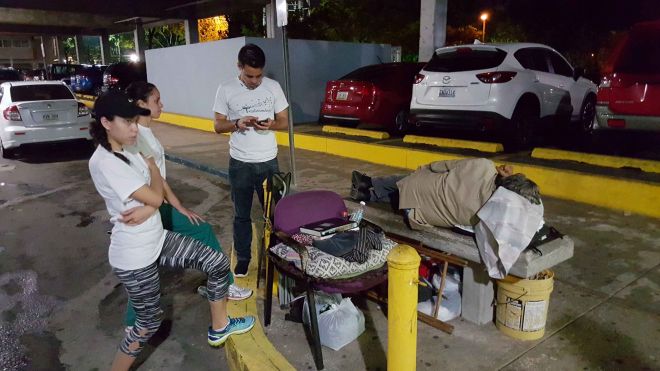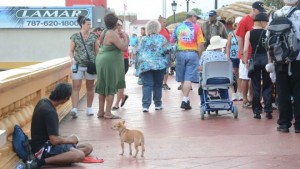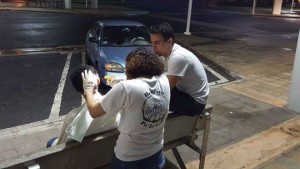
By Jan-Albert Hootsen
Published May 04, 2016 – Fox News Latino
SAN JUAN – As Puerto Rico scrambles to deal with its worst financial crisis by shutting down hospital wings, raising taxes and defaulting on the country’s monumental debt, at the street level ordinary residents try their best to adjust to a seemingly never-ending slump that is propelling the biggest exodus in modern Puerto Rican history.
The impact of the crisis is tangible everywhere you look. San Juan’s picturesque old center continues to attract tourists and cruise ships, but in Rio Piedras many businesses have closed.
 Almost half of the island’s population lives in poverty and 12 percent are unemployed. Homeless rates have doubled in five years and are bound to worsen by the end of 2016, as the number of mortgage executions is expected to hit the 26,000 — up from 11,000 homes foreclosed on last year.
Almost half of the island’s population lives in poverty and 12 percent are unemployed. Homeless rates have doubled in five years and are bound to worsen by the end of 2016, as the number of mortgage executions is expected to hit the 26,000 — up from 11,000 homes foreclosed on last year.
The number of drug addicts on the island has reached 185,000 out of a population of 3.5 million.
Relief in San Juan and other major cities comes in the form of volunteering and donations channeled through non-governmental, federally-funded organizations such as Iniciativa Comunitaria, where Alejandra Velez and other young college students work two nights a week for approximately four or five hours.
Velez said their work has become increasingly difficult in recent times as the debt crisis threatens to cascade into a full-blown catastrophe for the U.S. commonwealth.
She volunteers at Recinto Pa’la Calle, one of six aid groups run by Iniciativa Comunitaria. Along with her teammates, who are all in their early 20s and most of them students of medicine at the University of Puerto Rico, Velez cruises the city on a rotating schedule searching for homeless people, drug addicts and sex workers.
They set up makeshift infirmaries in different parts of town and look for people in need.
“It’s been raining, so it’s quiet tonight,” she told Fox News Latino recently, with a bunch of homeless men and a dozen stray cats staring quietly as she set up a tent on an abandoned parking lot. “We normally get to help between 50 and 80 people on a single night,” she said.
The focus of the aid group is to check on the homeless people’s health and provide them first aid, clothing, food and hygiene products. When the group finds someone with an untreated wound or abscess, they treat them on the spot, Velez said.
 “We’ve seen the number of people depending on our support rise,” said volunteer Héctor Ortiz, a student of hospital administration.
“We’ve seen the number of people depending on our support rise,” said volunteer Héctor Ortiz, a student of hospital administration.
“The people we care for have nowhere to go,” he said, as he handed out a bag containing shampoo and half a bar of soap. “It used to be a whole bar,” he noted.
In the past couple of years, Governor Alejandro García Padilla’s administration has significantly cut spending in health care and education, even while unemployment and poverty are on the rise.
Many choose to emigrate – just last year nearly 70,000 people moved off the island – but many others are not that lucky.
“There are definitely more of us now than there were a few years ago,” Willie, a homeless man who requested not to be identified except by a pseudonym, told FNL. One of the youngest of the group at the parking lot, Willie’s arms were covered in tattoos. “You just notice that it’s a crisis. People lose their homes and end up on the streets.”
“I ended up living on the street because I had a big fight with my wife over my kid,” he said. “I didn’t want to have to deal with it, but I didn’t have anywhere to go, no family that would take me in.”
He nods to his companions and the students. “These guys are my family now.”
Puerto Rico’s debt crisis is the result of a toxic mixture of decades of financial mismanagement, a bloated public sector and an economic recession that began in 2006. Not having statehood prohibits the island from declaring Chapter 9 bankruptcy, leaving its fate in the hands of the Congress in Washington, which so far has not found a solution.
Crushed beneath the weight of more than $70 billion in public debt, García Padilla announced on Sunday that the U.S. territory would not be able to make Monday’s deadline on $422 million in bond payments and declared a moratorium on such debt repayment. Despite the partial default, creditors and the island’s Government Development Bank (GDB) agreed to a framework to restructure some of the debt.
García Padilla called the agreement a “vital first step,” but further trouble looms. Almost $2 billion needs to be paid in July, and the governor does not expect Puerto Rico to have the money to pay.
“We invite the creditors to negotiate,” he said at a press conference Monday.
Some political observers say the worst is yet to come.
“In the short term nothing much will change, because the government won’t pay the bondholders,” said John Mudd, a San Juan-based lawyer and legal analyst specializing in bankruptcy law.
However, he said, within the next four to eight months the payment moratorium may be declared illegal and bring about even bigger problems – clauses on the missed payments may cause the unpaid $422 million to balloon to more than $4 billion.
“Puerto Rico would definitely not have the money to pay for that,” Mudd said.
Should that happen, Mudd and other observers suggest, Puerto Rico’s government could “collapse” and the financial crisis could become an even deeper humanitarian one.
Jan-Albert Hootsen is a freelance writer based in Mexico City. Follow him on Twitter: @Jayhootsen



jose Ortiz
May 30, 2016 -
Yo jose ortiz c lo recomiendo al sufrido x drogas no hay otro como ellos todos son exelentes.
jose Ortiz
May 30, 2016 -
Yo jose m ortiz hago fe que no hay otro como ustedes dios los bendiga si c puede.